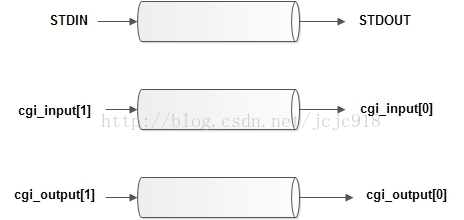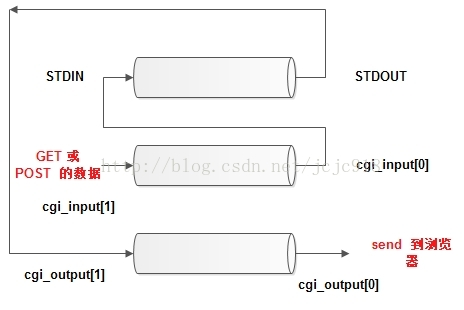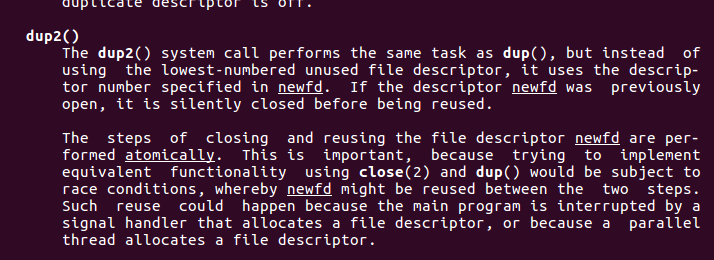Tinyhttpd源码剖析
简介
Tinyhttpd是一个不到500行的简单http服务器。
Makefile解析
all: httpd client
LIBS = -lpthread #-lsocket
httpd: httpd.c
gcc -g -W -Wall $(LIBS) -o $@ $<
client: simpleclient.c
gcc -W -Wall -o $@ $<
clean:
rm httpd
Makefile非常简单,定义了两个编译目标httpd(服务器程序)、客户端程序。
startup函数
这个函数意图比较明显,就是根据提供的端口号显示创建listen fd,而该listen fd是阻塞的。目前对SO_REUSEADDR选项还不是很清楚。
int startup(u_short port) {
int httpd = 0;
int on = 1;
struct sockaddr_in name;
httpd = socket(PF_INET, SOCK_STREAM, 0);
if (httpd == -1)
error_die("socket");
memset(&name, 0, sizeof(name));
name.sin_family = AF_INET;
name.sin_port = htons(*port);
name.sin_addr.s_addr = htonl(INADDR_ANY);
// 将套接字设置SO_REUSEADDR选项。
if ((setsockopt(httpd, SOL_SOCKET, SO_REUSEADDR, &on, sizeof(on))) < 0) {
error_die("setsockopt failed");
}
if (bind(httpd, (struct sockaddr *)&name, sizeof(name)) < 0) {
error_die("bind");
}
// 端口号为0,那么就动态的分配端口
if (*port == 0) {
socklen_t namelen = sizeof(name);
if (getsockname(httpd, (struct sockaddr *)&name, &namelen) == -1)
error_die("getsockname");
*port = ntohs(name.sin_port);
}
if (listen(httpd, 5) < 0)
error_die("listen");
return(httpd);
}
getsockname
这个函数用来查看OS动态给socket分配的端口信息等。
accept_request
创建listen fd之后,然后程序直接在本进程中accept,创建accept fd,然后来处理HTTP 请求。
void accept_request(void *arg) {
// intptr_t 什么时候用到不是很清楚。
int client = (intptr_t)arg;
// bug 解决:client值无效
client = *(int *) arg
char buf[1024];
size_t numchars;
char method[255];
char url[255];
char path[512];
size_t i, j;
struct stat st;
int cgi = 0;
char *query_string = NULL;
// 读取当前客户端发送而来的一行
numchars = get_line(client, buf, sizeof(buf));
i = 0; j = 0;
// 首先获取方法名称
while (!ISspace(buf[i]) && (i < sizeof(method) - 1)) {
method[i] = buf[i];
i++;
}
j=i;
method[i] = '\0';
// 如果不是GET 方法那么就直接返回GET没有实现
// 直接返回
if (strcasecmp(method, "GET") && strcasecmp(method, "POST")) {
unimplemented(client);
return;
}
// 如果是POST方法那么
if (strcasecmp(method, "POST") == 0)
cgi = 1;
i = 0;
while (ISspace(buf[j]) && (j < numchars))
j++;
while (!ISspace(buf[j]) && (i < sizeof(url) - 1) && (j < numchars))
{
url[i] = buf[j];
i++; j++;
}
//
url[i] = '\0';
if (strcasecmp(method, "GET") == 0) {
query_string = url;
while ((*query_string != '?') && (*query_string != '\0'))
query_string++;
if (*query_string == '?') {
cgi = 1;
*query_string = '\0';
query_string++;
}
}
sprintf(path, "htdocs%s", url);
if (path[strlen(path) - 1] == '/')
strcat(path, "index.html");
if (stat(path, &st) == -1) {
while ((numchars > 0) && strcmp("\n", buf)) /* read & discard headers */
numchars = get_line(client, buf, sizeof(buf));
not_found(client);
} else {
if ((st.st_mode & S_IFMT) == S_IFDIR)
strcat(path, "/index.html");
if ((st.st_mode & S_IXUSR) ||
(st.st_mode & S_IXGRP) ||
(st.st_mode & S_IXOTH) )
cgi = 1;
if (!cgi)
serve_file(client, path);
else
// 执行CGI脚本
execute_cgi(client, path, method, query_string);
}
close(client);
}
我们通过nc来调试 nc 127.0.0.1 4000

因为fafafafa是乱输入的,所以不支持该方法,上述是httpd返回的值。其执行流程如下:

下面是一个完整是GET一个完整的HTTP报文头部字段,返回的是htocs下的index文件信息。

execute_cgi 解析
在POST请求下,或者是GET请求,但有查询参数或请求资源为可执行程序下,execute_cgi将会被调用。
void execute_cgi(int client, const char *path,
const char *method, const char *query_string) {
char buf[1024];
int cgi_output[2];
int cgi_input[2];
pid_t pid;
int status;
int i;
char c;
int numchars = 1;
int content_length = -1;
buf[0] = 'A'; buf[1] = '\0';
if (strcasecmp(method, "GET") == 0) {
// 丢保其它报文头部字段
while ((numchars > 0) && strcmp("\n", buf)) /* read & discard headers */
numchars = get_line(client, buf, sizeof(buf));
} else if (strcasecmp(method, "POST") == 0) {
numchars = get_line(client, buf, sizeof(buf));
while ((numchars > 0) && strcmp("\n", buf)){
buf[15] = '\0';
if (strcasecmp(buf, "Content-Length:") == 0)
content_length = atoi(&(buf[16]));
numchars = get_line(client, buf, sizeof(buf));
}
if (content_length == -1) {
bad_request(client);
return;
}
}
else/*HEAD or other*/ {
}
if (pipe(cgi_output) < 0) {
cannot_execute(client);
return;
}
if (pipe(cgi_input) < 0) {
cannot_execute(client);
return;
}
if ( (pid = fork()) < 0 ) {
cannot_execute(client);
return;
}
sprintf(buf, "HTTP/1.0 200 OK\r\n");
send(client, buf, strlen(buf), 0);
if (pid == 0) /* child: CGI script */ {
char meth_env[255];
char query_env[255];
char length_env[255];
//子进程STDOUT重定向到管道1的写端中。
dup2(cgi_output[1], STDOUT);
// 子进程STDIN重定向管道0的读端到中。
dup2(cgi_input[0], STDIN);
// 关掉其它不用的一端
close(cgi_output[0]);
close(cgi_input[1]);
sprintf(meth_env, "REQUEST_METHOD=%s", method);
putenv(meth_env);
if (strcasecmp(method, "GET") == 0) {
sprintf(query_env, "QUERY_STRING=%s", query_string);
putenv(query_env);
}
else { /* POST */
sprintf(length_env, "CONTENT_LENGTH=%d", content_length);
putenv(length_env);
}
// 执行可执行程序。
execl(path, NULL);
exit(0);
} else { /* parent */
// 父进程关掉不用的一端
close(cgi_output[1]);
close(cgi_input[0]);
if (strcasecmp(method, "POST") == 0)
for (i = 0; i < content_length; i++) {
recv(client, &c, 1, 0);
// 向子进程一个字节一个字节的写。
write(cgi_input[1], &c, 1);
}
// 从输出管道中读入执行结果后发送给客户端。
while (read(cgi_output[0], &c, 1) > 0)
send(client, &c, 1, 0);
close(cgi_output[0]);
close(cgi_input[1]);
waitpid(pid, &status, 0);
}
}
管道的初始状态:

管道最终状态

- 在子进程中,把 STDOUT 重定向到 cgi_output 的写入端,把 STDIN 重定向到 cgi_input 的读取端,关闭 cgi_input 的写入端 和 cgi_output 的读取端,设置 request_method 的环境变量,GET 的话设置 query_string 的环境变量,POST 的话设置 content_length 的环境变量,这些环境变量都是为了给 cgi 脚本调用,接着用 execl 运行 cgi 程序。
- 在父进程中,关闭 cgi_input 的读取端 和 cgi_output 的写入端,如果 POST 的话,把 POST 数据写入 cgi_input,已被重定向到 STDIN,读取 cgi_output 的管道输出到客户端,该管道输入是 STDOUT。接着关闭所有管道,等待子进程结束。这一部分比较乱,见下图说明:
这里利用的是exec默认的输入和输出为STDIN和STDOUT,如果讲STDIN重定向后,那么CGI脚本将从cgi_input管道中读,执行完后的结果写到cgi_out管道中,然后父进程读取返回给客户端。
接口学习
-
getsockname用来获取OS给自己绑定的端口信息等。
-
stat用来查看文件的属性,是普通文件还是可执行文件
-
recv用来获取socket消息
-
send 用来将消息发送给协议栈
-
dup2 用一个新的文件描述符来复制一个旧的文件描述符,这样两个文件描述符共享同样的文件状态。这里的代码用dup2将管道和标准输入和输出联系一起。

-
pipe生产管道
坚持一步一个脚印的去实现自己的梦想!



